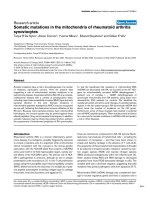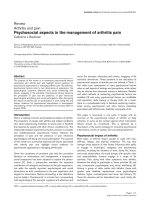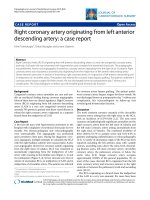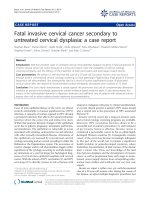Báo cáo y học: "Metaplastic ossification in the cartilage of the bronchus of a patient with chronic multi-drug resistant tuberculosis: a case report" potx
Bạn đang xem bản rút gọn của tài liệu. Xem và tải ngay bản đầy đủ của tài liệu tại đây (899.5 KB, 4 trang )
JOURNAL OF MEDICAL
CASE REPORTS
Eum et al. Journal of Medical Case Reports 2010, 4:156
/>Open Access
CASE REPORT
© 2010 Eum et al; licensee BioMed Central Ltd. This is an Open Access article distributed under the terms of the Creative Commons At-
tribution License ( which permits unrestricted use, distribution, and reproduction in any
medium, provided the original work is properly cited.
Case report
Metaplastic ossification in the cartilage of the
bronchus of a patient with chronic multi-drug
resistant tuberculosis: a case report
Seok-Yong Eum*
1
, Ji-Hye Kong
1
, Bo-Young Jeon
2
, Sang-Nae Cho
2
, Jhingook Kim
3
, Laura E Via
4
, Clifton E Barry III
4
and
Won-Jung Koh
3
Abstract
Introduction: Pulmonary ossification has been rarely observed in pulmonary fibrosis and in some chronic respiratory
diseases such as chronic obstructive pulmonary disease. We report here a metaplastic ossification in the bronchial
cartilage of a patient with multi-drug resistant tuberculosis.
Case presentation: We report the case of a 41-year-old Asian man from Korea with chronic multi-drug resistant
tuberculosis with a rare focus of bone formation from the cartilage of a bronchus subtending an active cavity. The
patient had a large multi-lobed, thick-walled cavitary tuberculosis lesion in his left upper lobe. Severe infiltration of his
lymphocytes and epithelioid cells, along with some giant cells and neutrophils, was observed in the patient's bronchial
wall. Desquamated bronchial epithelium and acid-fast bacilli were found inside his bronchus. A small focus of bony
metaplasia was found in the cartilage of his bronchial wall. Histopathological examination confirmed calcification and
showed hematopoietic cells forming in his marrow cavity.
Conclusions: Chronic inflammation in the lungs of our patient, caused by underlying tuberculosis, probably played a
role in the development of osseous metaplasia from the associated cartilage of the bronchial wall.
Introduction
Pulmonary ossification is rare and usually identified and
diagnosed post-mortem by the pathologist. This phe-
nomenon has been observed in pulmonary fibrosis and in
some chronic respiratory diseases such as chronic
obstructive pulmonary disease (COPD) [1-5]. We report
here an unusual case of bone formation in the bronchial
wall upon examination of surgically resected lung tissue
from a patient with multi-drug resistant tuberculosis
(MDR-TB) with chronic inflammation of the bronchial
wall.
Case presentation
A 41-year-old Asian man from Korea was referred for
treatment of MDR-TB. He had been previously treated
for MDR-TB with second-line anti-TB drugs for six years
at another institution. Despite this treatment, his sputum
smear and culture examinations were persistently posi-
tive. He used to smoke. He had a white blood cell count of
6260/μL, an erythrocyte sedimentation rate of 60 mm/h,
and his C-reactive protein levels were elevated at 0.65
mg/dL. His human immunodeficiency virus antibody test
was negative. On his chest X-ray examination, two cavi-
ties were observed in his left upper lobe. Acid-fast bacilli
(AFB) stain revealed florid bacilli in his sputum (4+).
Meanwhile, isolation and drug susceptibility testing
revealed a strain of Mycobacterium tuberculosis that was
resistant to all first-line anti-TB drugs including isoniazid,
rifampin, ethambutol, pyrazinamide, and streptomycin.
Among second-line agents this strain was also found to
be resistant to prothionamide, para-aminosalicylic acid,
and ofloxacin. The isolate retained sensitivity to kanamy-
cin, capreomycin, cycloserine, and moxifloxacin.
Accordingly, our patient was treated with a combina-
tion of anti-TB drugs including kanamycin, moxifloxacin,
* Correspondence:
1
Division of Immunopathology and Cellular Immunology, International
T
uberculosis Research Center, Masan, Republic of Korea
Full list of author information is available at the end of the article
Eum et al. Journal of Medical Case Reports 2010, 4:156
/>Page 2 of 4
cycloserine, amoxicillin-clavulanate, and clarithromycin.
Despite six months of chemotherapy, however, he still
failed to convert to sputum negative status, so he was
advised to undergo a left upper lobectomy and superior
segmentectomy of the left lower lobe. Tissue collection
from adult patients undergoing lung resection for the
management of MDR-TB was approved by the Samsung
Medical Center Institutional Review Board (IRB).
A thick-walled lesion containing multiple cavities was
observed in the left upper lobe of our patient by com-
puted tomographic (CT) examination (Figure 1). A
dilated bronchus with thickened wall and two individual
granulomas with central caseation were located close to
his cavity wall (Figure 2A). His bronchial epithelium was
degraded and replaced with a severe inflammatory cell
infiltrate. AFB were detected in the caseum inside the
bronchus (Figure 2B), indicating that this bronchus was
connected to the neighboring cavity. Several multi-nucle-
ated giant cells were found in his peribronchial region
(Figure 2B). Metaplastic ossification with fatty marrow
replaced a portion of the cartilage plate (Figure 3A). Dis-
tribution of calcium deposits was determined by von
Kossa staining and a dense band of calcium rimmed the
outer edge of his marrow cavity in the cartilage plate (Fig-
ure 3B).
To further evaluate the cellular components in his mar-
row cavity, immunohistochemical stains were performed
using antibodies to CD34 (DakoCytomation; monoclonal;
N1632) and CD68 (DakoCytomation; monoclonal; 1:50).
Some hematopoietic cells (CD34
+
) and macrophages
(CD68
+
) were found in the marrow cavity (Figure 3B).
Discussion
Pulmonary ossification could be defined as the histologi-
cal presence of mature bone in the pulmonary paren-
chyma. Metaplastic pulmonary ossification is uncommon
and is related to chronic lung disease. Patients are gener-
ally asymptomatic, but the condition can be associated
with other pulmonary diseases such as interstitial pneu-
monia, fibrosis, or bronchiectasis [6]. Pulmonary ossifica-
tion is not usually visible in chest X-ray. Consequently,
the disease is usually discovered by chance during
autopsy. High resolution computed tomography (HRCT)
might be of some help in finding calcification but histo-
pathological confirmation is required [2]. Treatment
options are not well established, largely due to a lack of
clinical diagnosis.
The metaplastic bones may be disseminated through-
out the lungs or localized within the bronchial walls. In
this case, we found a small focus of bony metaplasia in a
cartilagenous plate on the bronchial wall. The bronchial
cartilage is primarily responsible for maintaining the sta-
bility of the airways. Metaplastic ossification happens as
part of the aging process of the thyroid cartilage [7]. Poor
perfusion of the cartilage, resulting in reduced blood sup-
ply to the airways and reduced ability to control airway
infection is reported to be one cause for bronchial carti-
lage alterations in patients who underwent lung trans-
plantation [8]. Other reports suggest that bacterial
infection associated with cystic fibrosis induces meta-
plastic bone replacement, as well as the destruction and
elimination of the bronchial cartilage [9]. Degenerative
changes in the cartilage and increased perichondrial
fibrosis have been demonstrated in patients with COPD
and bronchial asthma [10].
Meanwhile, there was a previous report of a patient
with TB who developed metaplastic bone formation in
the lung [3]. This patient also had concomitant COPD
and severe fibrosis and bronchiectasis. A second case of
diffuse pulmonary ossification in the alveolar septa asso-
ciated with caseating granulomas was reported in a
patient that had developed TB and was [4]. In the case we
describe here, the observed bony metaplasia was a focal
spot in the cartilage limited to a severely inflamed bron-
chus. This bronchus was directly adjacent to a large cavity
that apparently drained caseum into the bronchial lumen
and wall. The stimulation caused by this chronic inflam-
mation might have led to the metaplastic transformation
of the cartilage.
Figure 1 A computed tomography scan of our patient that re-
turned sputum-smear positive for acid fast bacilli. He failed to
achieve sputum conversion even after receiving second-line anti-TB
drugs for six years. Two thick-walled independent cavities (arrows) are
shown in the right upper lobe and a surrounding consolidated region
is noted (asterisks).
*
Eum et al. Journal of Medical Case Reports 2010, 4:156
/>Page 3 of 4
Conclusion
Multiple factors are probably involved in the develop-
ment of bony metaplasia. Given that cartilage ossifies as a
result of an intense inflammatory reaction in the bron-
chial submucosa [9], the observations in case we describe
here suggest that persistent stimulation by chronic
inflammation in MDR-TB may occasionally induce the
development of osseous metaplasia from the cartilage of
the bronchial wall.
Consent
Written informed consent was obtained from our patient
for publication of this case report and any accompanying
Figure 2 Macroscopic and microscopic photographs showing a cavity (Cv) and an inflamed bronchus (Br). (A) Macroscopic examination of
the specimen (left rectangle) shows thickening of some parts of the cavity wall and the bronchial wall. Two individual caseated nodules (Nd) are lo-
cated close to the bronchus. Hematoxylin and eosin staining (original magnification, ×25) shows extensive infiltration of inflammatory cells within the
cavity wall. The bronchial epithelium is severely desquamated with some intact remaining regions (right rectangle). (B) An enlarged photograph of
right rectangle in A showing bronchial epithelium (BE) and bronchial cartilage (CT). Several multi-nucleated giant cells (GC) and severe mononuclear
cells infiltration are found in the bronchial wall and Ziehl-Neelsen staining (photograph in the rectangle, ×1000) detected some Mycobacterium tuber-
culosis bacilli in caseum. (Hematoxylin and eosin staining, ×100.)
AB
CT
BE
BE
GC
GC
X 1000
H&E 100X
Cv
Cv
Br
Nd
Br
H&E 25X
Figure 3 Metaplastic bone formation in the cartilage plate (CT). (A) The newly-formed bone marrow cavity (MC) is encircled by calcified bony
trabeculae (TR). This portion is further shown in B (hematoxylin and eosin staining, ×100). (B) Photograph shows calcified bony trabeculae (TR) stained
by Von-Kossa (100). Immunohistochemistry staining detected hematopoietic CD34+ cells (arrows in upper rectangle) and CD68+ macrophages (ar-
rows in lower rectangle) in the marrow cavity (MC).
MC
MC
CT
TR
A
H&E 100X
B
CD68+
CD34+
X 400
X 400
MC
TR
CT
Von-Kossa 100 X
Eum et al. Journal of Medical Case Reports 2010, 4:156
/>Page 4 of 4
images. A copy of the written consent is available for
review by the Editor-in-Chief of this journal.
Abbreviations
AFB: acid-fast bacilli; COPD: chronic obstructive pulmonary disease; MDR:
multi-drug resistant; TB: tuberculosis.
Competing interests
The authors declare that they have no competing interests.
Authors' contributions
SYE contributed to the histopathological evaluation, acquisition of data, and in
conceptualizing, drafting and writing the manuscript. JHK performed histo-
pathological and immunohistochemical examination of the specimens. BYJ
assisted in the manipulation of the specimen and critically revised the manu-
script. JK contributed to the operation of our patient and to the critical review
of the manuscript. SNC, LV and CB contributed to research, data acquisition,
and in the conception and critical revision of the manuscript. WJK contributed
to the pre-operative and post-operative management of our patient and in
drafting and writing the manuscript. All authors read and approved the final
manuscript.
Acknowledgements
This research was supported in part by the Intramural Research Program of the
NIH, NIAID and by a grant from the Bill and Melinda Gates Foundation and the
Wellcome Trust through the Grand Challenges in Global Health Initiative. We
appreciate the technical comments of Dr Isamu Sugawara of the Research
Institute of Tuberculosis in Japan.
Author Details
1
Division of Immunopathology and Cellular Immunology, International
Tuberculosis Research Center, Masan, Republic of Korea,
2
Department of
Microbiology, Yonsei University College of Medicine, Seoul, Republic of Korea,
3
Department of Thoracic Surgery and Department of Medicine, Samsung
Medical Center, Sungkyunkwan University School of Medicine, Seoul, Republic
of Korea and
4
Tuberculosis Research Section, Laboratory of Clinical Infectious
Disease, National Institute of Allergy and Infectious Diseases, National Institutes
of Health, Bethesda, Maryland, USA
References
1. Ryan CF, Flint JD, Muller NL: Idiopathic diffuse pulmonary ossification.
Thorax 2004, 59:1004.
2. Kim TS, Han J, Chung MP, Chung MJ, Choi YS: Disseminated dendriform
pulmonary ossification associated with usual interstitial pneumonia:
incidence and thin-section CT-pathologic correlation. Eur Radiol 2005,
15:1581-1585.
3. Shuangshoti S: Metaplasia of bone in lungs and bronchi: report of 2
cases. J Med Assoc Thai 1995, 78:103-107.
4. Chow LTC, Shum BSF, Chow WH, Tso CB: Diffuse pulmonary ossification:
a rare complication of tuberculosis. Histopathology 1992, 20:435-437.
5. Fried ED, Godwin TA: Extensive diffuse pulmonary ossification. Chest
1992, 102:1614-1615.
6. Chan ED, Morales DV, Welsh CH, McDermott MT, Schwarz MI: Calcium
deposition with or without bone formation in the lung. Am J Respir Crit
Care Med 2002, 165:1654-1669.
7. Mupparapu M, Vuppalapati A: Detection of an early ossification of
thyroid cartilage in an aldolescent on a lateral cephalometric
radiograph. Angle Orthod 2002, 72:576-578.
8. Yousem SA, Dauber JH, Griffith BP: Bronchial cartilage alterations in lung
transplantation. Chest 1990, 98:1121-1124.
9. Haraguchi M, Shimura S, Shirato K: Morphometric analysis of bronchial
cartilage in chronic obstructive pulmonary disease and bronchial
asthma. Am J Respir Crit Care Med 1999, 159:1005-1013.
10. Ogring G, Kampalath B, Tomashefski JF: Destruction and loss of
bronchial cartilage in cystic fibrosis. Hum Pathol 1998, 29:65-73.
doi: 10.1186/1752-1947-4-156
Cite this article as: Eum et al., Metaplastic ossification in the cartilage of the
bronchus of a patient with chronic multi-drug resistant tuberculosis: a case
report Journal of Medical Case Reports 2010, 4:156
Received: 26 November 2008 Accepted: 26 May 2010
Published: 26 May 2010
This article is available from: 2010 Eum et al; licensee BioMed Central Ltd. This is an Open Access article distributed under the terms of the Creative Commons Attribution License ( ), which permits unrestricted use, distribution, and reproduction in any medium, provided the original work is properly cited.Journal of Medical Case Reports 2010, 4:156









